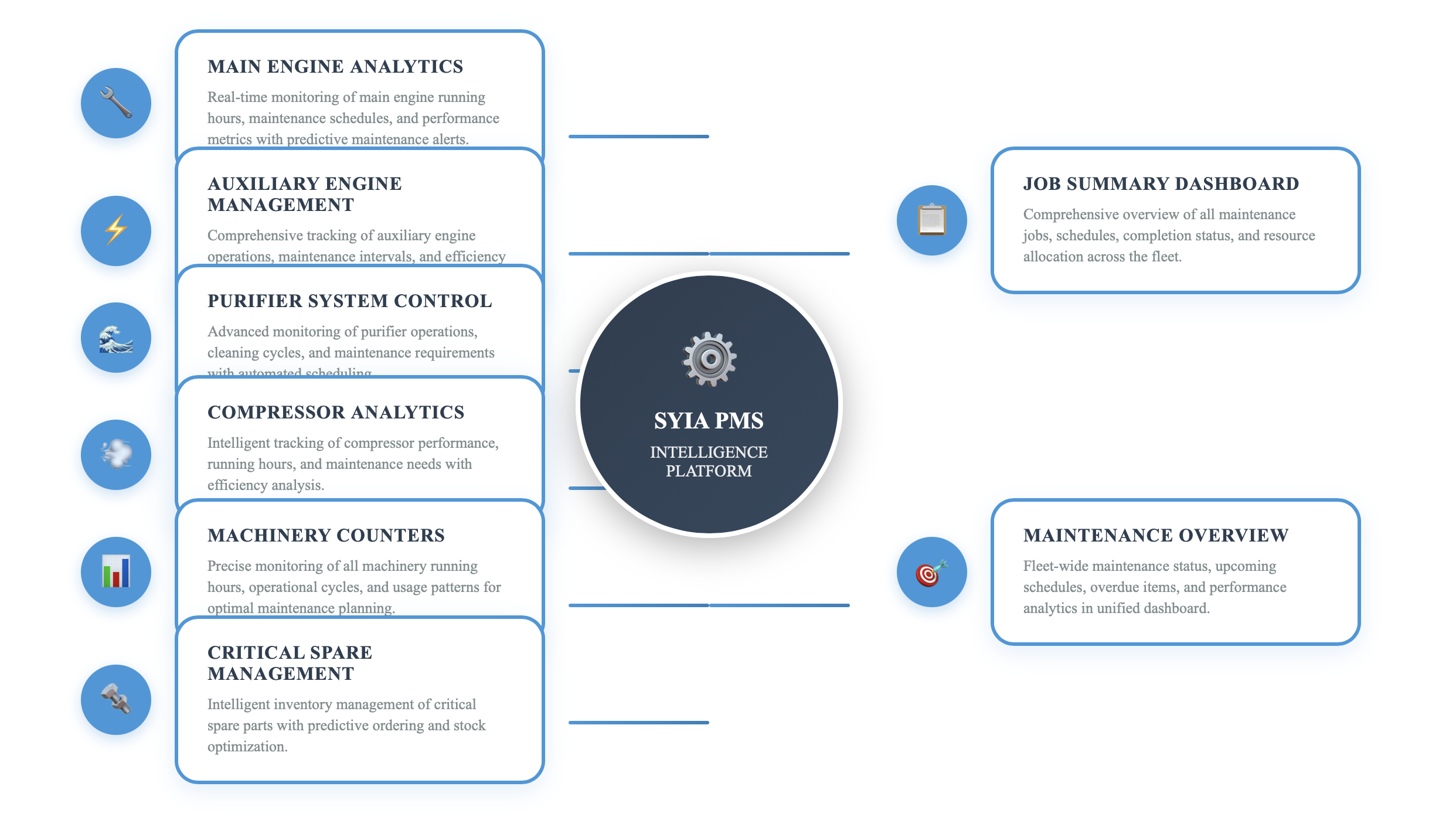
Data Architecture & Integration Flow
Primary Data Integration Pipeline
The SYIA PMS platform follows a robust data integration architecture that ensures secure, reliable, and real-time access to critical maintenance information. Key Integration Points:- ERP Systems: Direct integration with maritime ERP and legacy PMS systems
- Data Security: Enterprise-grade encryption and secure data transmission
- Real-time Processing: Continuous data synchronization with minimal latency
- Scalable Architecture: Cloud-native design supporting fleet expansion
ETL Processing Architecture
Comprehensive Data Transformation Pipeline
Our advanced ETL pipeline processes complex maintenance data through multiple stages of validation, transformation, and enrichment to deliver actionable insights.Key Capabilities
🔧 Main Engine Analytics
Real-time monitoring of main engine running hours, maintenance schedules, and performance metrics with predictive maintenance alerts.
⚡ Auxiliary Engine Management
Comprehensive tracking of auxiliary engine operations, maintenance intervals, and efficiency optimization across the fleet.
🌊 Purifier System Control
Advanced monitoring of purifier operations, cleaning cycles, and maintenance requirements with automated scheduling.
💨 Compressor Analytics
Intelligent tracking of compressor performance, running hours, and maintenance needs with efficiency analysis.
Core PMS Modules
1. Machinery Monitoring & Analytics
Comprehensive Equipment Intelligence:- Real-time operational status monitoring across all critical machinery systems
- Predictive maintenance scheduling based on equipment performance patterns
- Advanced performance analytics with trend identification and forecasting
- Automated alerting system for critical parameter deviations and maintenance requirements
2. Equipment-Specific Intelligence
🔧 Operational Excellence
- Automated performance optimization
- Intelligent maintenance scheduling
- Resource allocation efficiency
- Cost-effective operations management
📊 Performance Analytics
- Real-time monitoring and diagnostics
- Predictive failure analysis
- Energy consumption optimization
- Preventive maintenance strategies
3. Critical Spare Parts Management
Our intelligent inventory management system ensures optimal spare parts availability while minimizing carrying costs:- Predictive Ordering: AI algorithms forecast spare parts requirements based on usage patterns
- Stock Optimization: Dynamic inventory levels based on vessel routes and maintenance schedules
- Supplier Integration: Automated procurement workflows with preferred suppliers
- Cost Analysis: Comprehensive tracking of spare parts costs and usage efficiency
4. Maintenance Job Orchestration
Job Summary Dashboard:- Centralized view of all maintenance activities across the fleet
- Resource allocation and scheduling optimization
- Progress tracking with real-time status updates
- Performance metrics and completion analytics
- Fleet-wide maintenance status monitoring
- Overdue item identification and prioritization
- Maintenance cost analysis and budgeting
- Regulatory compliance tracking
AI-Powered Analytics & Insights
Machine Learning Capabilities:- Pattern Recognition: Advanced algorithms identify maintenance patterns and predict future requirements
- Anomaly Detection: Real-time monitoring detects unusual equipment behavior before failures occur
- Optimization Algorithms: AI-driven scheduling optimizes maintenance windows and resource allocation
- Performance Forecasting: Predictive models estimate equipment lifespan and replacement timing
Key Performance Indicators
Operational Metrics:- Equipment availability and uptime percentages
- Maintenance cost per vessel and per equipment type
- Mean time between failures (MTBF) analysis
- Resource utilization and efficiency rates
- Maintenance schedule optimization recommendations
- Cost reduction opportunities identification
- Risk assessment for critical equipment
- Performance improvement suggestions
Integration Benefits
Operational Excellence
- Reduced Downtime: Predictive maintenance reduces unplanned equipment failures.
- Cost Optimization: Intelligent scheduling and inventory management optimize maintenance costs
- Compliance Assurance: Automated tracking ensures regulatory compliance and certification requirements
- Resource Efficiency: Optimized parts allocation improve operational efficiency
Strategic Advantages
- Data-Driven Decisions: Comprehensive analytics support strategic fleet management decisions
- Scalable Platform: Cloud-native architecture supports fleet expansion and growth
- Competitive Edge: Advanced AI capabilities provide significant operational advantages
- Risk Mitigation: Proactive maintenance reduces operational risks and insurance costs

